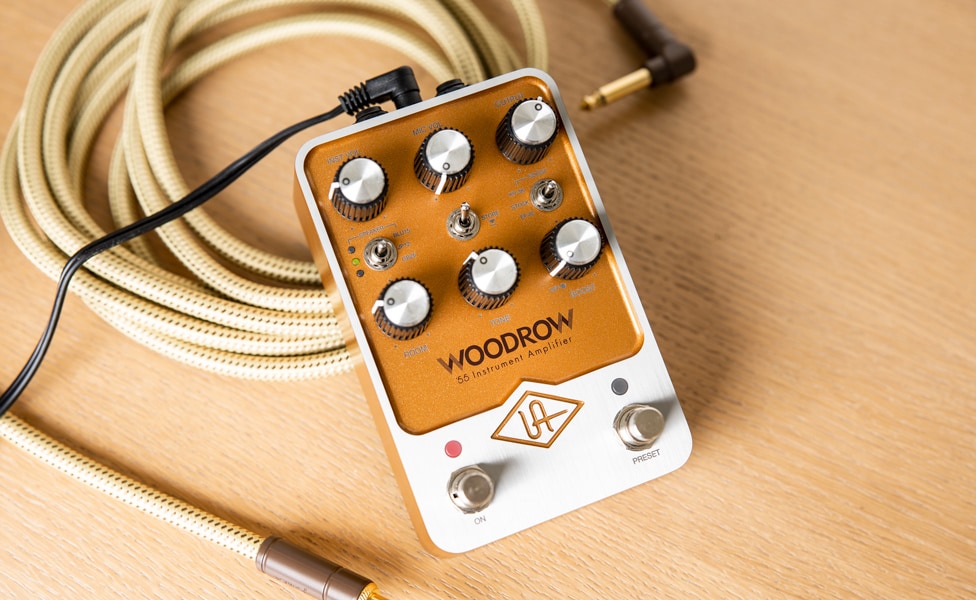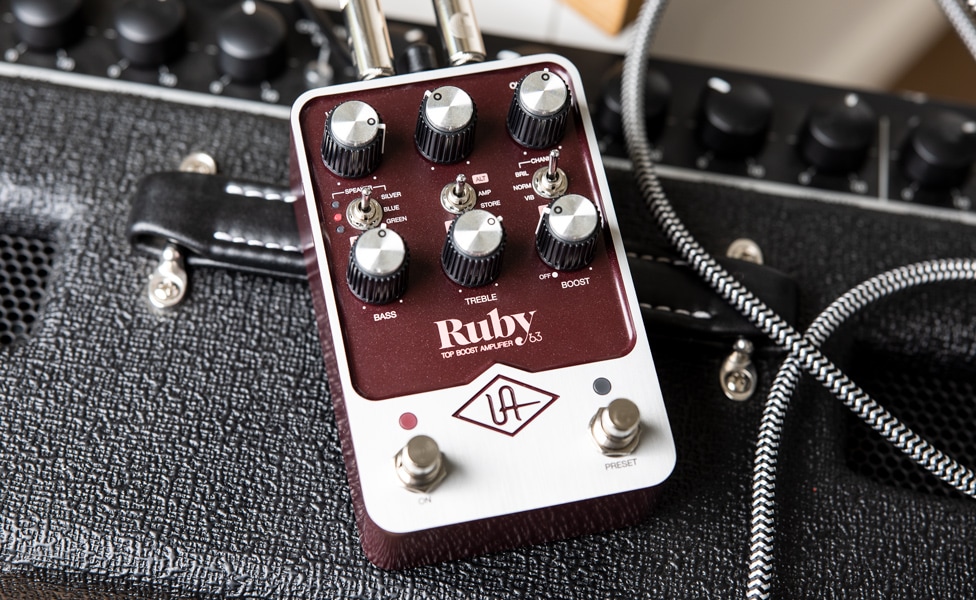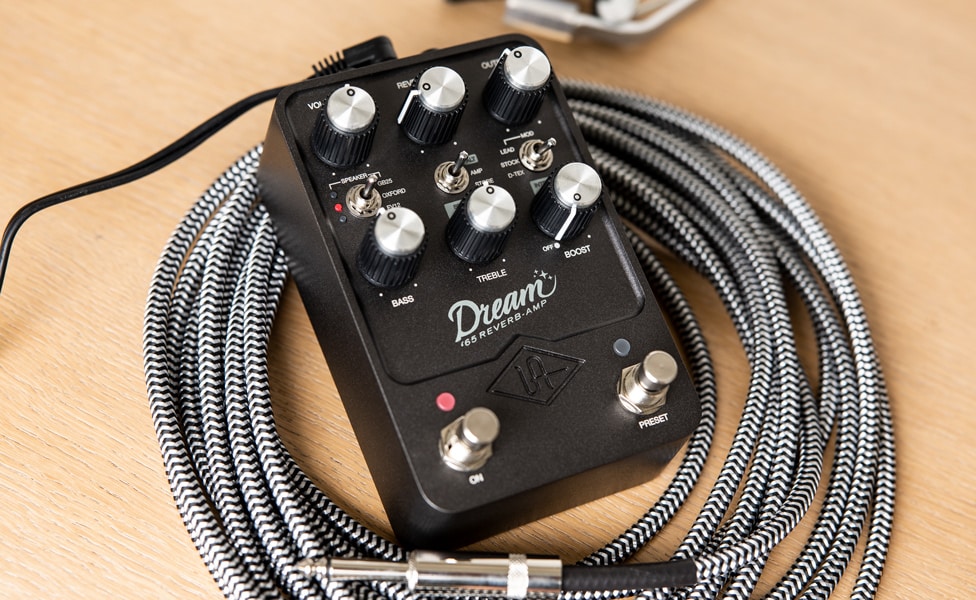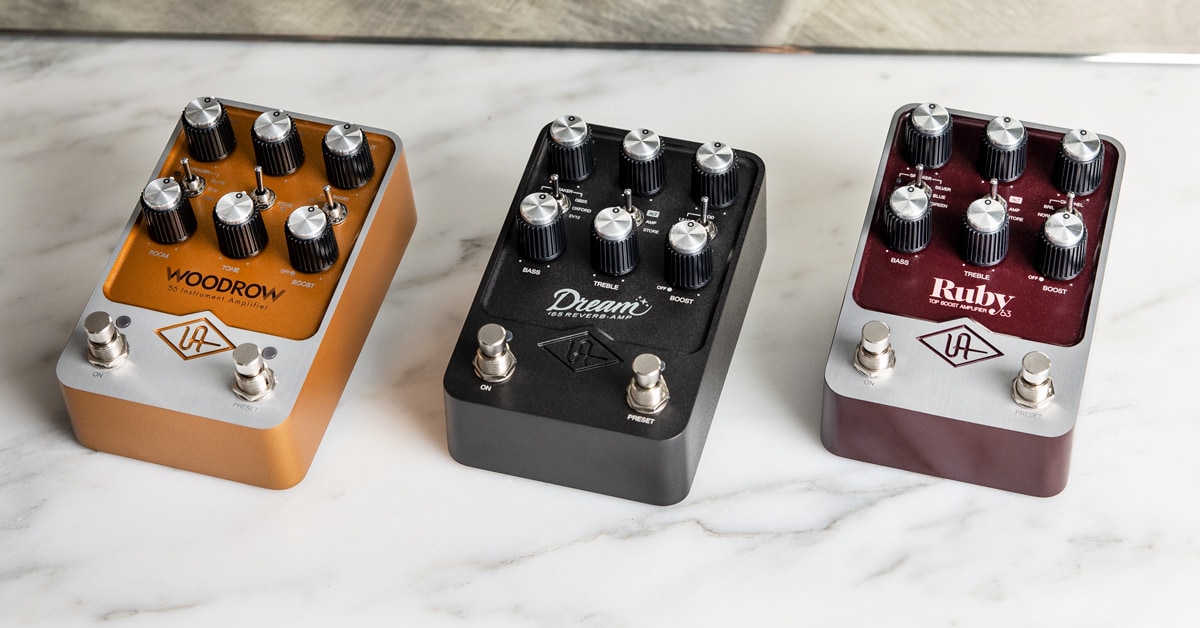From their start in the 1950s under the leadership of Bill Putnam, Sr., Universal Audio has been a company to look to for technological innovation that just happens to sound absolutely stellar. As the company evolved over the years into digital as well as analog realms, that’s become even more so. The new UA Amp Emulator pedals—Woodrow ’55, Dream ’65 and Ruby ’63—follow in the footsteps of their 2021 launch of the UAFX pedals which recreated classic modulation, echo/delay and reverb effects. The new Amp Emulator pedals offer up stunning, pedalboard-friendly recreations of some of the most in-demand vintage guitar amplifiers in the world—a 1955 5E3-circuit Fender Tweed Deluxe (Woodrow), a mid-’60s AB763-circuit Fender Deluxe Reverb (Dream) and an early ‘60s Vox AC30 (Ruby), done with the level of precision to detail, sound and feel that we’ve come to expect from the folks at UA.
We had the chance to sit down for a conversation with UA Senior Product Manager Tore Mogensen and Senior Product Designer James Santiago to talk about some of the thought, experience and design expertise that went into the Amp Emulator pedals.
These pedals are designed to capture the sound and feel of a trio of iconic amplifiers. How did you settle on these particular models?
Tore Mogensen: The goal was really to make pedals that would capture some of the most iconic guitar tones ever created; amps that you would, and still will, find in every well-stocked studio. At the same time, we also wanted to make sure that the three pedals represented radically different tones. Regardless of whether you prefer to set your amp totally clean, on the verge of breakup, or fully cranked, the Tweed, Black Panel and AC30 circuits are completely different, and you can’t really use one to get the tone of any of the other amps. We are aware, of course, that there are a few other obvious amps missing … but who knows what the future will bring?
These are coming on the heels of the 2021 launch of the UAFX pedal line, which introduced the Astra Modulation Machine, Starlight Echo Station and Golden Reverberator. What made you turn to amp modeling, rather than continuing with effects?
TM: While there are definitely tons of cool effects we could, and would, love to do on the UAFX platform, the choice became pretty simple when we realized that we could actually fit the Tweed Deluxe plug-in on the UAFX platform. Our amplifier algorithms are incredibly detailed. They require massive amounts of computing power and wouldn’t run on most—or really any other—pedals currently on the market. With the realization that the UAFX processor was fast and powerful enough to run the amp modelling algorithms without any compromises, the decision was pretty much a no-brainer. Being able to design virtual amps of this caliber, and with this tonal accuracy, is such a treat.
Was there anything you learned from those pedals that was incorporated into how you approached these?
TM: I don’t think we learned anything particularly revolutionary, apart from just realizing that the main UA mantras of tonal quality and ease-of-use are still the right way for us to go as a company. We even took this philosophy of distilling, rather than diluting, one step further, with each pedal representing just one amp where the original three pedals had three different emulations each. It became obvious that this decision was right when we started A/B-ing the real amps to the pedals. That feeling of setting the pedals and the amps exactly the same and not being able to tell them apart was really powerful, and I think that anybody familiar with these circuits will feel immediately at home using these pedals.

Pictured: Universal Audio UAFX Woodrow '55 Instrument Amplifier Effects Pedal
How do you see these pedals fitting into most players’ rigs?
TM: The goal from the very start was that users should be able to use the pedals in any conceivable scenario and setup imaginable. If we split use cases up into two main categories it would be with and without a real amp.
For users looking for an alternative to a real amp, the pedals can be used for practicing and recording going into any interface of choice, as well as for rehearsing and playing live plugged directly into the P.A. at their rehearsal space or front-of-house at a venue.
For users wanting to use it with a real guitar amp, the cab, microphone and room mic circuit can be bypassed, which allows for a number of different setup possibilities. The user can set their amp clean and place the pedals along with the rest of their drive pedals as an extra tonal flavor. Or, they can place the pedals at the end of the signal chain and plug directly into the effects loop return of their amp to bypass the preamp of the real amp entirely. Last, but not least, the pedals also feature a 4-cable mode where the preamp of the real amp will be placed in a “loop” of the pedals. This means that the preamp of the real amp will be in the signal chain when the pedal is bypassed, but out of the signal chain when the pedal is active. This essentially adds an additional Tweed, Black Panel, or AC30 channel to any tube amp, that can be turned on and off just as easily as switching channels on an amp. You could actually add all three pedals with that approach.
On top of that, I want to stress that we deliberately designed the pedals and the algorithms to work and react to real overdrive, boost, distortion and fuzz pedals just as the real amps do. So, if your favorite tone is a cranked Black Panel amp with a vintage TS808 in front, there is no need to change your rig if you choose to leave your Super Reverb at home and bring a Dream ‘65 instead.
Can you change the output behavior or voicing of the pedals for different applications. For example, going direct versus hitting the front of an amp?
James Santiago: Since these are pedals, I thought the first thing we needed to do was make them pedalboard-level-friendly. If you put the Output at noon, that’s roughly unity gain to your bypassed guitar volume. That way if you’re using other instrument level pedals for your delay, reverb or special FX, you won’t have any issues. If the Output is past 3 o’clock or higher, you get closer to a Line-level output.
TM: As James said, the goal really was to make sure the pedals can work and behave as expected in every setup and scenario. So, on the input side, the pedals have plenty of headroom to handle both low output pickups as well as hot signals, like you’d get from from Line-level instruments or boost or overdrive pedals that have been cranked. Ruby ‘63 will sound just like a real AC30 with 30dB of added gain from a cranked treble booster in front of it.
Similarly, we also wanted to make sure that we offer unity gain as well as plenty of output level if a user wants to use the pedal to push their real tube amp like they would with any standard overdrive or distortion pedal. The ability to really crank out some volume on the output side was also important for certain settings, like setting Woodrow ‘55 super clean. It’s such an awesome tone, but something that is virtually impossible with the real amp as you’d have to set the volume so low that you’d barely be able to hear it! On Woodrow you just crank the Output control and you have all the headroom in the world.
Tell us a little bit about your pursuit of the “golden units” used in this project.
JS: Many of the amps we used I’ve hunted down over several years. I always listen to a number of original units before even considering one as a reference unit. Even then I’ll use a couple, like in the case of Woodrow. I have my own stock tweed Deluxe from 1955, but I also searched for a second one that I thought would pair nicely. I went through an entire room of tweed Deluxe amps! Some amps are just magical, and in slightly different ways from each other. For Ruby, that’s actually two different AC30 amps, one being a non-Top Boost model from 1960, and the Top Boost model is from late ’63/early ‘64. We ended up with the Vox amps in Europe since those are a little harder to find in the States. I’ve owned lots of Fender amps over the years, and mine have been modded so I did end up finding one of the best sounding, totally stock Deluxe Reverb amps from a friend at a local shop. Even when I find a great amp, I still spend a lot of time finding the perfect tubes and we’re always servicing them, so they sound great through the entire multi-year modeling process.
When people think of the “sound” of these amps, they are drawing on a lot of different experiences: playing them, seeing someone perform with them or simply hearing them on recordings. Are you modeling the “sound in the room” when someone is playing, or is there some amount of adjustment to find a happy medium for all those different experiences someone may have had?
JS: Well, we model every single component in the amp signal chain. If that amp has tremolo and spring reverb, so will ours. We even modeled the harmonic tremolo channel in the AC30s, which everyone usually forgets about! Beyond that, it’s really a question of the speaker cabs and how they’re miked. I followed a similar process to what I did when I designed the OX cab/mic sounds. That meant making them sound like they’re in a great studio and dialed in to sound like a record. For example, if you dial up a “Bohemian Rhapsody”-style lead sound in Ruby, I made sure the Silver Alnico speakers get that exact tone. I did that for every speaker cab option on every pedal. Plus, I was able to write lots of presets you can get via the app with tons of custom mic, cab and amp settings.

Pictured: Universal Audio UAFX Ruby '63 Top Boost Amplifier Effects Pedal
Each pedal allows you to choose from three classic speaker options commonly associated with each amp. Can you tell us a little bit about that selection process and exactly how that was captured?
JS: Tore and I really wanted a “greatest hits” collection of speakers most associated with each amp type. For example, Dream has a tonal speaker range that goes from Greenback-style for overdriven lead, to pristine clean with JBLs. Before we even start the modeling process, we assemble all the real configurations in the studio. I can’t tell you how many months, years even, [that] I’ve been collecting and testing all the different speakers that ended up in the pedals! Just finding the perfect ‘80s-era EV12L was a long journey. You never know how good they sound until you put them in the cabs and use them at gigs and record them. I’ve always been like this for my personal gear as well, though. I know what every speaker in any one of my vintage 4x12” cabs sounds like. It never fails that one sounds great for clean sounds, or one’s better for lead. And, there’s always one I never like!
I’ll try and give a quick summary of what speaker and cabinet options are in each:
For Woodrow ’55, we give you all the classic 1x12 “Blue”- and “Green”-style options. Plus, we give you a 4x10 Tweed, and even a 4x12 vintage option. This gives you everything from American “ small” “Tweed” tones to half-stack British-flavored rock.
With Dream ’65 you get three of the most classic 1x12” player upgrades from vintage Blue, to Greenback to high-power EV-L-type. The extra cab options go from 2x12” vintage JBL for jam band-approved cleans, to Black Panel 4x10”, and even a closed back 2x12” with 65s for modern blues tones.
When you plug into Ruby ’63, you’ve got all the classic eras of vintage Silver and Blue alnico speakers in their original cabinets. For the non-Top Boost, amp on 10 “singing” lead tones, the Silver set from 1960 is just unbeatable. When you get to the Top Boost, the different Blue speaker eras have this airy chime that’s unique to this setup. With single-coil pickups, this is that jangly tone that we’ve all been chasing. We also decided to add a couple of modern speakers like Green and even Gold-types.
In addition to different speaker configurations, each pedal offers different “flavors” of sound. Woodrow offers three different boost circuits; Dream offers three different “mods” and Ruby offers three different boost & channel variations. Can you bring us into that development process a little bit?
TM: The choices were, in most cases, pretty obvious. The legendary Black Panel amp tones from famous amp modders like Howard Dumble, Paul Rivera and Cesar Diaz are such an integral part of that circuit that it was a no-brainer for Dream ‘65. For Woodrow ‘55 we wanted to offer both chime-y “The Edge”-style tones as well as more midrange-heavy “Bonamassa”-like sounds, and the Korg SDD-3000 and EP-3 preamps really help push the amp in these two directions. On Ruby ’63, the Dallas Rangemaster Treble Booster plus the Normal channel setup was a very easy decision as both Brian May and Rory Gallagher used that combination. They are inarguably two of the best guitar tones ever created. Adding the EP-3 preamp to the Brilliant channel was probably the one decision we debated the most.
I noticed that you don’t put the SDD on the Ruby ’63.
We definitely could’ve included the Korg SDD-3000 preamp, but both James and I felt that the Korg pre added more high-end frequencies to what is already a really “trebly” amp. This is why we ended up going for the EP-3 booster, as it rounds off the top end nicely and really complements the amp in a cool way.

Pictured: Universal Audio UAFX Dream '65 Reverb Amplifier Effects Pedal
We talked through all of the speaker options earlier, some of which are available to you after you register. What’s the process for getting those on your pedal?
TM: It’s actually really easy! The UAFX pedals have Bluetooth and all you have to do to download the extra cabs to your pedal is download the UAFX Control app for your iPhone or Android phone, and pair the app and pedal to register it to your UA account.
What does the USB-C integration offer?
TM: The USB-C connection is strictly for firmware updates. You can also use it to register your pedal if you don’t have access to an iPhone or Android phone. All the “cool” functionality such as accessing user, factory and artist presets, deeper pedal setup, etc. is handled through the mobile app. I can’t stress enough how much I recommend that users try the app out!
Were there any challenges or unique discoveries you came across as you were developing these pedals?
JS: From a design philosophy standpoint, I tried to respect the unique quirks of each amp. A Woodrow reacts just like both of the real ‘55 amps that I have here. If you put it on 10, it has a tube fuzz quality and starts to implode. Could we have fixed that and taken out the crazy sputtering? Sure, but then it’s not the wild ride that the original is! In fact, you can hear that exact sound if you listen to the solo in “One of These Nights”. That’s nothing but a Les Paul into a tweed Deluxe on 10. That’s the sound, and we’re not going to “fix” that. On Ruby, you can absolutely get into crazy bright sounds, but with the right guitar and playing style, you play a certain way that makes that work and is magical. We hope that hardcore fans of each of these amps not only get the tones they expect, but more importantly, the feel and dynamics, too!
.jpeg)







